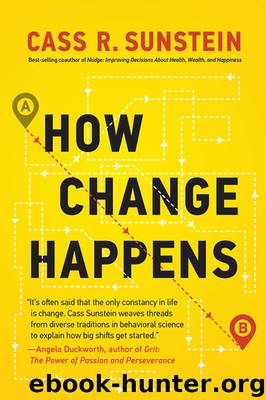How Change Happens by Cass R Sunstein

Author:Cass R Sunstein
Language: eng
Format: epub
Tags: unleashed; behavioral economics in the real world; behavioral science; political philosophy; nudge; group polarization; expressive function of law; welfare; ethics; coercion; separate evaluation; joint evaluation; transparency; Precautionary Principle; moral heuristics; human rights; partyism; enclave deliberation; social cascades; social norms; The World According to Star Wars
Publisher: MIT Press
Published: 2019-03-19T00:00:00+00:00
Illustrations
The five arguments on behalf of choice-preserving approaches will have different degrees of force in different contexts. They suggest reasons to favor nudges over mandates, but those reasons may not be decisive. In some settings, for example, the interest in freedom of choice has overwhelming importance. In others, people do not much care about it, and its intrinsic value is only modest. Consider some illustrative problems:
1. Suppose that a large university has long had a single-sided default for its printers, and it is deciding whether to change to double-sided. On the basis of careful investigation, suppose that it has learned that at least 80 percent of its students, faculty, and other employees would prefer a double-sided default, on the ground that they would like to save paper. Armed with this information, and aware of the economic and environmental savings that a double-sided default could bring, the university switches to that default.
Now suppose that some university administrators, enthusiastic about the idea of majority rule, ask whether double-sided printing should be mandatory. The answer to that question is plain. About one-fifth of users prefer a single-sided default, and there is little doubt that single-sided printing is often best—for example, for PowerPoint presentations and for lecture notes.
The assessment might be different if the use of single-sided printing imposes significant costs on nonusers (e.g., paper costs on the university or environmental costs). If so, there is some weighing to be done. But if the welfare of those who use printers is the only or primary variable, a default is clearly preferable to a mandate. From the standpoint of users, a mandate would impose unnecessary costs in the face of heterogeneity across persons and projects. Here, then, is a clear case in which a default is preferable to a mandate.
2. As we have seen, a great deal of work explores the effects of automatic enrollment in retirement plans. We have also seen that automatic enrollment increases participation rates, and thus people’s savings, while also preserving freedom of choice: so far, so good. The problem is that if the default contribution rate is lower than what employees would choose (say, 3 percent, as it has been under many automatic enrollment plans), then the result of automatic enrollment might be to decrease average savings because the default rate turns out to be sticky. This is an ironic result for those who want to use defaults to increase people’s welfare during retirement.
The natural response, however, is not to abandon default rules in favor of mandates, but to choose a better default. One possibility is automatic escalation, which increases savings rates each year until the employee hits a predetermined maximum. And in fact, there has been a significant increase in the use of this approach; automatic escalation is increasingly popular. Another possibility is to select a higher default contribution. No one denies that defaults can go wrong. If they do, the challenge is to get them right.
But there is a more fundamental objection, which questions freedom of choice altogether. Suppose that
Download
This site does not store any files on its server. We only index and link to content provided by other sites. Please contact the content providers to delete copyright contents if any and email us, we'll remove relevant links or contents immediately.
The Secret History by Donna Tartt(18943)
The Social Justice Warrior Handbook by Lisa De Pasquale(12165)
Thirteen Reasons Why by Jay Asher(8841)
This Is How You Lose Her by Junot Diaz(6831)
Weapons of Math Destruction by Cathy O'Neil(6213)
Zero to One by Peter Thiel(5729)
Beartown by Fredrik Backman(5671)
The Myth of the Strong Leader by Archie Brown(5456)
The Fire Next Time by James Baldwin(5379)
How Democracies Die by Steven Levitsky & Daniel Ziblatt(5169)
Promise Me, Dad by Joe Biden(5112)
Stone's Rules by Roger Stone(5051)
A Higher Loyalty: Truth, Lies, and Leadership by James Comey(4904)
100 Deadly Skills by Clint Emerson(4876)
Rise and Kill First by Ronen Bergman(4739)
Secrecy World by Jake Bernstein(4698)
The David Icke Guide to the Global Conspiracy (and how to end it) by David Icke(4654)
The Farm by Tom Rob Smith(4464)
The Doomsday Machine by Daniel Ellsberg(4447)
